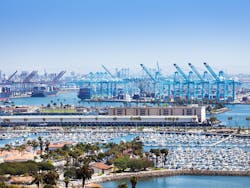Long Beach Says California Decision Fails to Remove Key Barrier to Microgrids. Calls for Rehearing
The city of Long Beach has filed a formal challenge to a recent California microgrid decision, saying that the order does not reduce the barriers to microgrid development to the extent required under state law.
The city is calling for a rehearing on the January decision by the California Public Utilities Commission to create microgrid tariffs and undertake other efforts to advance microgrids. The proceeding emerged out of a state law, SB 1339, designed to boost commercialization of microgrids.
Long Beach said the decision does not fulfill the law’s mandate, citing its failure to remove restrictions that delayed construction of a Port of Long Beach microgrid. The microgrid is part of an effort to fully electrify the port’s marine terminals to achieve zero emissions by 2030.
The port also is planning additional microgrids, according to the city’s February 22 filing with the commission. (Rulemaking 19-09-009)
The filing said that the solar plus storage microgrid experienced delay and “near death” as a result of what’s known as Rule 18, which prohibits a Southern California Edison customer from reselling electricity received from the utility.
Clear and present barrier
“Rule 18 is a clear and present barrier to microgrid development. In fact, as demonstrated by the port’s microgrid experience, it is potentially fatal to development of microgrids and to the power systems resilience needed at electrified, zero-emissions marine terminals,” said the city, acting on behalf of the Board of Harbor Commissioners.
At issue is the fact that the energy storage systems within the microgrid are partially charged by utility power and sold to a private entity at the port.
“In situations where a microgrid includes a storage facility charged by a combination of electricity received from an investor-owned utility (IOU) and electricity received from the microgrid’s own generator, the IOU can (and did so in the port’s microgrid experience) assert that the electricity withdrawn from the storage facility cannot be resold to another party. This is because there is no practical way to differentiate the electrons withdrawn from the storage facility that came from the IOU from the electrons which came from the microgrid’s own generation,” said the filing.
Microgrid decision did not resolve storage issue
The commission did make some changes to Rule 18 but they did not resolve the crux of the problem, the city said. “Absent from the decision is any explanation as to how a microgrid, even if it meets the other criteria of the decision, can utilize storage to serve another entity,” said the filing.
The city is asking the commission to add language to Rule 18 that would make exceptions for energy withdrawn from an energy storage device by the owner or operator of a microgrid. The recommended language includes protections against overcharging customers and maintaining safety standards.
The Port of Long Beach was able to overcome its issues by negotiating a waiver with the utility. But the city described the waiver as ad hoc and said a more global solution is required.
The port awarded Schneider Electric a $5.2 million contract in 2018 to build the project, which includes a solar array, battery storage and diesel generator.
Microgrid necessary for reliable power
The port, which accounts for nearly one-fifth of containers moving through US ports, says the microgrid is necessary to ensure reliable power as it increasingly electrifies its operations.
Electricity demand at the port is dependent on arrival times of ships, which are unpredictable because of weather, cargo handling times at other ports and other factors. The port needs to be sure reliable electricity is available for the ships because delaying them at anchor is “cost prohibitive,” said the filing.
“In addition vessels often carry perishables that cannot be delayed from delivery. A port which cannot promptly off load vessels will quickly be bypassed by shippers which will direct their vessels to other ports. This will, in turn, adversely impact jobs at the port, which are an important part of local and regional employment.”
The port’s microgrid is designed for the Port’s Joint Command and Control Center, which manages response and surveillance operations.
That microgrid will also have a low-voltage cable between the control center and Jacobsen Pilot Service, which is responsible for shepherding ships into the harbor. During power outages the microgrid will provide electricity to the control center and JPS. Under normal conditions, the microgrid will be used to shave peak load demand and provide demand response services.
Track news about the Port of Long Beach microgrid. Subscribe to the free Microgrid Knowledge Newslettter.







